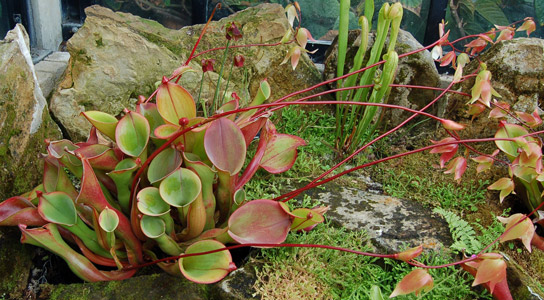
Pitcher plants. Credit: alexlomas/Flickr
The carnivorous pitcher plant lures insects to their doom with drops of nectar. South American pitcher plants have developed an ingenious insect-trapping mechanism to keep insects from escaping their grasp.
Plant biologist Ulrike Bauer of the University of Cambridge in the United Kingdom and colleagues published their findings in the journal Proceedings of the Royal Society B. The throat of Heliamphora nutans is covered in a pelt of tiny, precisely oriented hairs that are difficult to ascend. The hairs create a slippery, wet film on the pitcher plant’s inner walls, making it almost impossible for its victims to get a grip. They end up plunging into the bottom of the pitcher, where they drown in a pool of water.
The features described in this study are quite sophisticated. These kinds of plants aren’t easy to study in the wild. H. nutans lives atop high plateaus in the wilds of southeastern Venezuela. Scientists need to a helicopter and a permit from the Venezuelan government to access this area. The permits aren’t easy to get, so Bauer and his team worked with specimens of the plant from the collections of London’s Royal Botanic Gardens in Kew.
When examined with a scanning electron microscope, researchers saw that the pitcher’s throat was covered in dense hair, numbering more than 100,000 and all pointing downwards. An Asian ant species, Camponotus rufifemur, was allowed to stroll into a dry pitcher, only 29% fell into the abyss. The ants that ventured onto the longer hairs toward the bottom were the most likely to fall. When ants were released onto a wet pitcher, 88% went down the slope. The researchers dubbed this phenomenon insect aquaplaning.
Another Asian ant species, Oecophylla smaragdina, was equipped with tiny strain gages. The team also removed the adhesive foot pads, which help ants grip onto smooth surfaces from one group, but left another group intact. The ants were then placed onto sections of a pitcher wall, which were pulled out from underneath their feet.
In tests replicating an ant’s journey down into a pitcher, ants without adhesive pads couldn’t get a grip on a dry pitcher wall, whereas intact ants couldn’t get a grip on a wet pitcher wall but did manage to get a purchase on a dry wall. The wet pitcher surface counteracts the ant’s adhesive foot pads. The claws of the ants can’t save them because all of the hairs are pointing downward.
Some Asian pitcher plants also use the “aquaplaning” method—a textbook example of convergent evolution, Bauer says, because Asian and South American pitchers are as related to each other “as we are to flatworms.”
Reference: “‘Insect aquaplaning’ on a superhydrophilic hairy surface: how Heliamphora nutans Benth. pitcher plants capture prey” by Ulrike Bauer, Mathias Scharmann, Jeremy Skepper and Walter Federle, 22 February 2013, Proceedings of the Royal Society B.
DOI: 10.1098/rspb.2012.2569









Be the first to comment on "Pitcher Plant’s Ingenious Way of Trapping Ants"